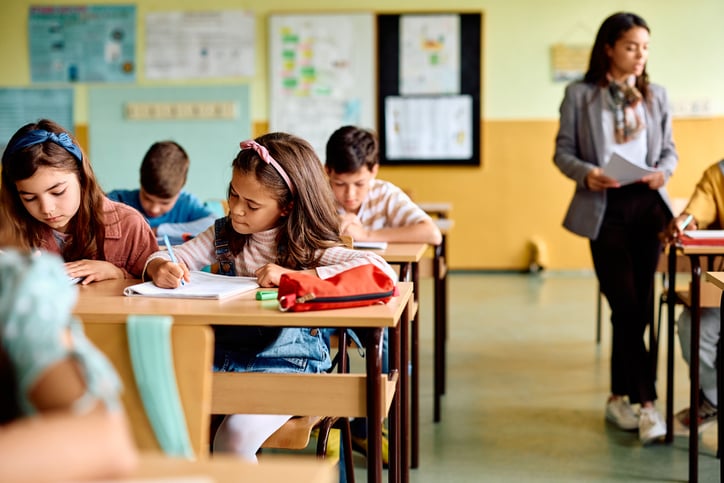

During the past decade, interpreter and translator services have soared across public and public charter schools in the US.
In today’s increasingly multilingual and neurodiverse schools, collaboration is essential to support all learners. When we succeed, fail, and reflect together, we not only develop collective efficacy but also model the 21st-century skills we want to develop in our learners (Nordmeyer, 2015). Intentional and strategic co-planning, co-teaching, co-assessing, and co-reflecting promote equitable, language-rich learning environments for multilingual learners (Dove and Honigsfeld, 2018, 2022). However, collaboration is not just an effective instructional approach. It is also a catalyst for professional learning: building capacity for all teachers to share responsibility for all students.
In the past decade, many schools worldwide have transformed how they serve diverse school communities. On one hand, schools have shifted away from the fragmentation and segregation of pull-out or withdrawal programs, with specialists planning and delivering language development classes, academic interventions, or special education services in isolation; on the other hand, schools have shifted toward the greater cohesion and integration offered by collaborative planning and in-class support (Honigsfeld and Nordmeyer, 2020). In the process of researching and building professional learning opportunities for collaboration, we have documented teachers sharing the work of planning and delivering integrated language and content instruction that promotes the success of multilingual learners (Dove and Honigsfeld, 2018; Honigsfeld and Dove, 2019; Greenberg Motamedi et al., 2019; Nordmeyer, 2015).
Coaches and specialists in learning support, special education, and language development can be invaluable resources for the entire school community, sustaining student learning and professional growth. The first part of this article explores how to build capacity for professional collaboration: creating the necessary conditions by developing an intentional culture and structures to support effective collaboration. The second part of this article will consider how to build generative and sustainable capacity through collaboration: by shifting from fragmentation to integration, professional collaboration can build more cohesive and inclusive schools, providing meaningful learning experiences for all.
Building Capacity FOR Collaboration
To help teachers maximize their work together at the classroom level, school leaders need to build a school-wide shared culture and create structures to facilitate collaboration. All educators need to develop skills, knowledge, and dispositions to allow effective collaborative practices to thrive. Shifting beliefs and attitudes helps to establish the foundation for building new teaching practices. For example, we intentionally use multilingual learners rather than English language learners (ELLs) in order to recognize the diverse linguistic assets that students bring to our classrooms, rather than positioning English at the expense of other languages. A National Education Association (2015) publication clearly indicated that multilingual learners “desperately need educators who believe in them, who recognize their assets, and who have the support and training they need to do their best by all of their students” (p. 19). Teacher collaboration is one pathway for educators to examine their core beliefs and daily practices. Focus strategies that create the conditions for teachers to work together include defining collaboration, emphasizing co-planning over co-teaching, and making TIME for co-planning.
Many researchers of inclusive education as well as practitioners in schools with collaborative school cultures emphasize the need to work together with intention. Some capture the essence of this work in the shape of a collaborative instructional cycle, which consists of four interrelated components: collaborative planning, instruction, assessment, and reflection (see Figure 1). All four phases are needed to maximize teacher effectiveness and impact MLs’ language and literacy development, academic learning, and social–emotional growth. While co-teaching itself might receive substantial attention, teachers need time and structured opportunities for the other three components of the collaborative instructional cycle: (a) thinking deeply about content and language integration and differentiated, scaffolded instruction; (b) gathering formative and summative student data and planning appropriate evidence-based instruction; and (c) reflecting on the teaching–learning process that took place in the class. This is not necessarily a linear or sequential process; however, neglecting any one part of this cycle may disrupt the balance and continuity of the collaborative work needed to positively impact student learning.
Educators can also define collaboration by using a menu approach (Mulazzi and Nordmeyer, 2010). By creating a menu listing different options for co-planning, co-teaching, co-reflecting, and co-assessing practices, educators not only provide concrete examples but also promote the notion of choice. In the same way that a restaurant would not expect a customer to order every single item on its menu, educators would not expect a colleague to engage in all collaborative practices at the same time.
Building on the menu metaphor, this approach helps to increase the appetite for collaboration while breaking the process into bite-size options. Different teachers can choose options based on what students need as well as their individual tastes and comfort levels. A menu can be co-developed by a department or division and can be refreshed each year.
Co-Planning > Co-Teaching
One of the most important aspects of collaboration happens outside the co-taught classroom: when teachers plan together. In fact, through our work with schools over the past two decades we have observed how co-planning is as important as—if not more important than—co-teaching. It is clear that co-teaching cannot be effective without co-planning, but co-planning can be effective even if teachers do not have the opportunity to collaboratively deliver their co-planned unit or lesson. Every teacher can support multilingual learners by integrating language and content; students at every proficiency level deserve to engage with challenging academic content. By building on what students can do, teachers can co-plan to scaffold learning, differentiate instruction, and meaningfully engage all learners.
However, in order to co-develop universally designed learning, teachers need both time and structures: to share what they know about students, what they know about the curriculum, and what they know about effective instruction and assessment. Using shared co-planning protocols, graphic organizers, or placeholders for language scaffolds on unit planners will invite teachers to literally “think inside the box” and consider how multilingual learners can be meaningfully engaged in every lesson.
TIME Is Essential
Almost universally, when we have worked with educators around the world, one of the most common sentiments is that “we don’t have enough time” for effective co-planning. Clearly, school leaders cannot ask teachers to plan together without providing adequate space within the school day. Additionally, once this time is set aside, teachers can maximize this precious commodity by focusing on TIME:
- Trust: Get to know each other and build a shared commitment. While the pandemic has certainly fostered a spirit of “we are all in this together,” explicit norms and agreements can also help to build solid partnerships.
- Intention: Establish a specific focus and concrete goals for the co-planning meeting. Including this on a calendar invitation or shared agenda ensures everyone is on the same page.
- Materials: Ensure all electronic or paper materials are available, including both student data and curriculum documents, for all participants. This is particularly important when a specialist joins a team meeting.
- Expectations: School leaders can communicate that this valuable co-planning time is protected, so it will be used only to co-develop materials and approaches focused on improving teaching and learning. This prevents co-planning time being co-opted for other meetings.
Building Capacity THROUGH Collaboration
As outlined above, cultural and structural foundations create the conditions for effective collaboration. In schools that have established effective collaborative practices, the impact is clear: language-rich learning environments throughout the instructional day serving all learners. In addition, implementing shared practices allows the entire school community to experience collaboration as professional development.
In fact, working together to serve a diverse group of students also builds collective teacher efficacy and provides valuable, job-embedded opportunities for reciprocal learning (Hattie, 2015, 2018). Mature partnerships facilitate relational trust, and collaboration reflects an asset-based approach. This not only facilitates student agency through dynamic meaning-making but also increases teacher agency.
Teachers are artists, musicians, comedians, poets; building on what teachers can do maximizes their expertise and reveals their unique talents. Likewise, professional learning opportunities that are embedded, daily, and reciprocal help to reduce burnout and engage teachers in a community of practice.
When teacher collaboration is recognized as sustained and generative professional learning—supporting both students and teachers—it is clearly a good investment. Teachers and administrators can agree that time and resources are well spent, advancing a shared commitment to an inclusive, integrated approach to serving all learners.
Leadership Strategies
Teachers need to work together in today’s increasingly diverse schools, and school leaders play an essential role in both creating the conditions for effective collaboration and maximizing the impact of collaboration in their schools.
Insights and Lessons Learned
Teacher collaboration is becoming the norm across schools and classrooms around the world. School leaders can create a vision for more cohesive, integrated, and collaborative schools. Implementing and sustaining this vision requires deliberate and intentional strategies. Some key ideas to keep in mind:
- Conditions for effective collaboration include a school-wide cultural shift, shared beliefs about collective efficacy, and commitment to equitable learning environments.
- Transparent and visible structures such as scheduling, teacher assignment, and student placement need to value and prioritize collaboration.
- Recruiting and hiring practices can contribute to building capacity by engaging educators with experience and/or interest in collaboration.
- Investing time and resources in collaboration is a cost-effective strategy to increase both student learning and teacher growth.
Each school context is unique, so reciprocal learning opportunities are essential to continue developing collaborative approaches for serving diverse learning populations. We have seen that the global community of educators presents opportunities for sharing innovation through research, social media, conferences, and professional learning events. This open dialogue ultimately raises our collective efficacy and helps schools worldwide to create more equitable learning environments for all students.
Insights and Lessons Learned
Teacher collaboration is becoming the norm across schools and classrooms around the world. School leaders can create a vision for more cohesive, integrated, and collaborative schools. Implementing and sustaining this vision requires deliberate and intentional strategies. Some key ideas to keep in mind:
Conditions for effective collaboration include a school-wide cultural shift, shared beliefs about collective efficacy, and commitment to equitable learning environments.
Transparent and visible structures such as scheduling, teacher assignment, and student placement need to value and prioritize collaboration.
Recruiting and hiring practices can contribute to building capacity by engaging educators with experience and/or interest in collaboration.
Investing time and resources in collaboration is a cost-effective strategy to increase both student learning and teacher growth.
Each school context is unique, so reciprocal learning opportunities are essential to continue developing collaborative approaches for serving diverse learning populations. We have seen that the global community of educators presents opportunities for sharing innovation through research, social media, conferences, and professional learning events. This open dialogue ultimately raises our collective efficacy and helps schools worldwide to create more equitable learning environments for all students.
References
Dove, M. G., and Honigsfeld, A. (2018). Co-Teaching for English Learners: A Guide to Collaborative Planning, Instruction, Assessment, and Reflection. Corwin.
Greenberg Motamedi, J., Vazquez, M., Gandhi, E., and Holmgren, M. (2019). English Language Development Minutes, Models, and Outcomes: Beaverton School District.
Hattie, J. (2015). What Works Best in Education: The Politics of Collaborative Expertise. Pearson.
Hattie, J. (2018). Collective Teacher Efficacy.
Honigsfeld, A., and Dove, M. G. (2019). Collaborating for English Learners: A Foundational Guide to Integrated Practices. Corwin.
Honigsfeld, A., and Dove, M. G. (2022). Co-Planning: 5 Essential Practices to Integrate Curriculum and Instruction for English Learners. Corwin.
Honigsfeld, A., and Nordmeyer, J. (2020). “Better Together: Evidence for co-teaching and collaboration in today’s classrooms.” AAIE InterEd Journal, 48, 129.
Mulazzi, F., and Nordmeyer, J. (2012). “Coteaching as Professional Development.” In A. Honigsfeld and M. G. Dove (Eds.), Coteaching and Other Collaborative Practices in the EFL/ESL Classroom (pp. 219–230). Information Age Publishing.
National Education Association (2015). How Educators Can Advocate for English Language Learners (ELLs): All In!
Nordmeyer, J. (2010). “At the Intersection of Language and Content.” In J. Nordmeyer and S. Barduhn (Eds.), Integrating Language and Content (pp. 1–13). TESOL Press.
Nordmeyer, J. (2015). “Collaboration: Scaffolding student learning and teacher learning.” EARCOS Tri-Annual Journal, Winter 2015, 29–40.
Schon, D. A. (1990). Educating the Reflective Practitioner: Toward a New Design for Teaching and Learning in the Professions. Jossey-Bass.
Jon Nordmeyer ([email protected]) is the school network director of the Multilingual Learning Research Center (MLRC) at the University of Wisconsin-Madison. His research focuses on building capacity to serve multilingual learners through global teacher networks. He is co-editor of Integrating Language and Content (TESOL, 2010) and has published in Teachers College Record, Global Education Review, Educational Leadership, and International Schools Journal.
Andrea Honigsfeld ([email protected]) is professor of TESOL teacher education in the School of Education at Molloy University. She is a Fulbright Scholar; an award-winning author, co-author, or co-editor of over 25 books and 60 articles; a national and international presenter; and a former EAL/ESOL teacher.














